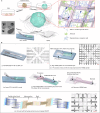Three-dimensional liquid metal-based neuro-interfaces for human hippocampal organoids
- PMID: 38744873
- PMCID: PMC11094048
- DOI: 10.1038/s41467-024-48452-5
Three-dimensional liquid metal-based neuro-interfaces for human hippocampal organoids
Abstract
Human hippocampal organoids (hHOs) derived from human induced pluripotent stem cells (hiPSCs) have emerged as promising models for investigating neurodegenerative disorders, such as schizophrenia and Alzheimer's disease. However, obtaining the electrical information of these free-floating organoids in a noninvasive manner remains a challenge using commercial multi-electrode arrays (MEAs). The three-dimensional (3D) MEAs developed recently acquired only a few neural signals due to limited channel numbers. Here, we report a hippocampal cyborg organoid (cyb-organoid) platform coupling a liquid metal-polymer conductor (MPC)-based mesh neuro-interface with hHOs. The mesh MPC (mMPC) integrates 128-channel multielectrode arrays distributed on a small surface area (~2*2 mm). Stretchability (up to 500%) and flexibility of the mMPC enable its attachment to hHOs. Furthermore, we show that under Wnt3a and SHH activator induction, hHOs produce HOPX+ and PAX6+ progenitors and ZBTB20+PROX1+ dentate gyrus (DG) granule neurons. The transcriptomic signatures of hHOs reveal high similarity to the developing human hippocampus. We successfully detect neural activities from hHOs via the mMPC from this cyb-organoid. Compared with traditional planar devices, our non-invasive coupling offers an adaptor for recording neural signals from 3D models.
© 2024. The Author(s).
Conflict of interest statement
The authors declare no competing interests.
Figures






References
-
- Andersen, P., Morris, R., Amaral, D., O’Keefe, J. & Bliss, T. The Hippocampus Book (Oxford University Press, USA, 2007).
MeSH terms
Grants and funding
LinkOut - more resources
Full Text Sources
Molecular Biology Databases

